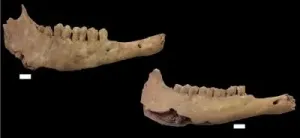Early Neolithic farmers modified the reproductive cycle of sheep
Over 7,500 years ago early farmers set down the foundations of livestock strategies that persist today
2021-04-21
(Press-News.org) The results, exceptional first time evidence of how early flocks of domesticated sheep fed and reproduced within the Iberian Peninsula, are currently the first example of the modification of sheep's seasonal reproductive rhythms with the aim of adapting them to human needs.
The project includes technical approaches based on stable isotope analysis and dental microwear of animal remains from more than 7,500 years ago found in the Neolithic Chaves cave site in Huesca, in the central Pyrennean region of Spain. The research was coordinated from the Arqueozoology Laboratory of the UAB Department of Antiquity, with the participation of researchers from the University of Zaragoza, the Museum of Natural History of Paris, and the Catalan Institute of Human Palaeocology and Social Evolution (IPHES) in Tarragona.
"The alteration of seasonal breeding rhythms in livestock represented a huge milestone for prehistoric societies, making it possible to have access to meat and milk throughout the year, and this in turn had a huge impact on diet, on the economy and on the social organisation of the first farming communities, and set down the bases for farming strategies which continue to be carried out now. Until very recently, animal husbandry in the Neolithic period was thought to be in its initial stages, although new possibilities in biogeochemical analyses used in this study have revealed husbandry practices that were fully consolidated since the beginning of the Neolithic", says Dr Maria Saña, lecturer at the UAB Department of Prehistory and coordinator of the project.
The domestication of sheep did not occur in the Iberian Peninsula. Its agriotype, the Ovis orientalis, can be found in central and southeastern Asia. "What is surprising is the speed in which the sheep are integrated into animal husbandry strategies and their enormous economic importance in the earliest periods of the Neolithic. What we see is a rapid and successful adoption, which demonstrates that their mechanisms of adaptation to both the new environment and their new economic role were well known and controlled by a part of human communities. The selective pressures applied on the species were artificial, they pursued specific objectives and were well defined. This new evidence represents a turning point in the research into animal domestication and the origins of animal husbandry. It was made possible by the new approach that we took with this study, focused on exploring the changes in breeding and feeding of these first flocks of sheep", states Alejandro Sierra, researcher at the UAB and at the University of Zaragoza, and first author of the article recently published in Journal of Archaeological Science: Reports.
The research focused on the study of sheep rearing in the Neolithic Chaves cave (5600-5300 BCE) in the Pyrennean foothills, a site that is "spectacular for the quality and number of remains recovered. When compared to Neolithic levels of fauna, its 12,754 recognisible remains are at least threefold of what is found in other Neolithic sites on the peninsula, with domesticated sheep and goats being the most numerous species, and with the largest presence of pigs of all the Neolithic sites. All of this points to the stabling of animals and to the type of stable settlement known to be dedicated to animal husbandry, and within a large cave that had 3,000 square metres of habitable space", affirms Pilar Utrilla, professor at the University of Zaragoza and director of the archaeological interventions.
The results obtained at the Chaves site show that in the Iberian Peninsula, the birth of lambs also occurred in autumn and winter seasons, which is what is now considered to be an "out of optimal season" birthing, an aspect that contrasts significantly with the livestock regimes documented in other parts of Europe during the Neolithic, with births occurring mainly in spring. The modification of the natural birthing cycles of wild sheep affected the physiology of the animals of this species, prolonging their fertility period. That was the result of a more intense and continued human control, alterating interactions between females and males, a breeding strategy that seeked greater predictability in livestock production. "Autumn birthing in the early Neolithic in the Chaves cave would confirm the antiquity of this practice in the Western Mediterranean basin, implying a combination of the biological capacity of sheep, zootechnical skills of the agricultors, and favourable environmental conditions", states Dr Marie Balasse, researcher at the Museum of Natural History in Paris.
The study also demonstrates that this greater control and selective pressure also had an effect on the diet and movement of the species. By applying for the first time a combination of dental microwear and stable C-13 and O-18 isotope analyses on sequencial samples of second and third molar enamel bioapatite, scientists were able to detect that the flock of sheep at Chaves did not eat a greatly varied diet, neither among the sheep nor throughout the year. The results of the dental microwear show that Neolithic sheep had a more controlled diet than wild animals living in the same types of environments and which grazed on good plant covers, with still very little human impact on their lives. The sheep would graze near the cave during most of the year, and were probably also fed forage. The verification of the use of extraordinary forage is also a novelty. "The results of what the sheep from the Chaves cave ate are surprising when compared with what we expected. We were able to document diets consisting of intensive and established differences between young and adult sheep, and these characteristics can be related to a tight control on livestock production during those earliest periods of the Neolithic", states Dr Florent Rivals, ICREA research professor at the IPHES.
"The results obtained on the breeding and feeding of sheep of the Chaves cave are key for the discovery of economic systems in early farming societies of the Iberian Peninsula. The new methodology applied in this study will no doubt be fundamental in further studying animal husbandry in prehistoric times", concludes Dr Alejandro Sierra.
INFORMATION:
[Attachments] See images for this press release:

ELSE PRESS RELEASES FROM THIS DATE:
2021-04-21
Most battery materials, novel catalysts, and storage materials for hydrogen have one thing in common: they have a structure comprised of tiny pores in the nanometer range. These pores provide space which can be occupied by guest atoms, ions, and molecules. As a consequence, the properties of the guest and the host can change dramatically. Understanding the processes inside the pores is crucial to develop innovative energy technologies.
Observing the filling process
So far, it has only been possible to characterise the pore structure of the substrate materials precisely. The exact structure of the adsorbate inside the pores has remained hidden. To probe this, a team from the HZB together with colleagues ...
2021-04-21
The natural menopause occurs when the menstrual periods cease due to the naturally decreased ovary function. There is a significant interindividual variation in the age at natural menopause but, on average, women undergo it around the age of 51 in Western countries. Furthermore, the length of the preceding menopausal transition, characterized by irregular menstrual cycles and menopausal symptoms, is also known to vary between individuals.
The study revealed that higher estradiol and follicle-stimulating hormone levels, irregular menstrual cycles, and menopausal symptoms are strong indicators of approaching menopause in middle-aged women. Additionally, information related ...
2021-04-21
DALLAS - April 21, 2021 - Food banks should be used more consistently rather than only during emergencies to better address food insecurity and related health issues, a joint study by researchers at UT Southwestern Medical Center and economists at the University of Dallas shows.
"The main discovery in our research is that encouraging clients and making it easier for clients to receive food frequently improves their food security, health, and well-being," says Sandi Pruitt, Ph.D., associate professor of population and data sciences at UT Southwestern, and senior author of the ...
2021-04-21
Perhaps no other ocean creature lives in the human imagination like the great white shark. But while great white sharks might be plentiful in the minds of beachgoers across the country, there are only a handful of places in the world where white sharks can be consistently found. In those areas -- such as Central California, Guadalupe Island Mexico, South Australia and South Africa -- they tend to be found aggregated in small hotspots, often located around seal colonies.
Researchers have estimated that white shark populations are incredibly small, with only hundreds of large adults and a few thousand white sharks total in any of their global ...
2021-04-21
UNIVERSITY PARK, Pa. -- A new approach to gene editing using the CRISPR/Cas9 system bypasses disease-causing mutations in a gene, enabling treatment of genetic diseases linked to a single gene, such as cystic fibrosis, certain types of sickle cell anemia, and other rare diseases. The method, developed and tested in mice and human tissue cultures by researchers at Penn State, involves inserting a new, fully functional copy of the gene that displaces the mutated gene.
A proof-of-concept for the approach is described in a paper appearing online April 20 in the journal Molecular Therapy.
The CRISPR/Cas9 system has allowed promising new gene therapies ...
2021-04-21
The number of solar panels within shortest distance from a house is the most important factor in determining the likelihood of that house having a solar panel, when compared with a host of socio-economic and demographic variables. This is shown in a new study by scientists using satellite and census data of the city of Fresno in the US, and employing machine learning. Although it is known that peer effects are relevant for sustainable energy choices, very high-resolution data combined with artificial intelligence techniques were necessary to single out the paramount importance of proximity. The finding is relevant for policies that aim at a broad deployment of solar panels in order to replace unsustainable ...
2021-04-21
The lifestyle and eating habits of human groups that have lived for thousands of years can be examined by tooth. An international research group analyzed the prehistoric findings of the Neolithic Age. In addition to providing knowledge about the lifestyles of people who lived in prehistoric times, a novel study of tooth remains paved the way for other methods previously not used. This study applies the complementary approaches of stable isotope and dental microwear analyses to study the diets of past people living in today's Hungary. Their joint results were published in the scientific journal Scientific Reports.
The Great Hungarian Plain is considered one of the most interesting areas for archeology because ...
2021-04-21
Coronavirus researchers led by Professor Rolf Hilgenfeld of the University of Luebeck and PD Dr. Albrecht von Brunn of the Ludwig-Maximilian Universitaet (LMU) in Munich have discovered how SARS viruses enhance the production of viral proteins in infected cells, so that many new copies of the virus can be generated. Notably, coronaviruses other than SARS-CoV and SARS-CoV-2 do not use this mechanism, which may therefore provide a possible explanation for the much higher pathogenicity of the SARS viruses. The findings appear in the EMBO Journal.
Coronaviruses that cause harmless colds in humans were discovered more than 50 years ago. When it emerged in 2002/2003, the SARS coronavirus was the first coronavirus found to cause severe pneumonia ...
2021-04-21
For more sustainability on a global level, EU legislation should be changed to allow the use of gene editing in organic farming. This is what an international research team involving the Universities of Bayreuth and Göttingen demands in a paper published in the journal "Trends in Plant Science".
In May 2020, the EU Commission presented its "Farm-to-Fork" strategy, which is part of the "European Green Deal". The aim is to make European agriculture and its food system more sustainable. In particular, the proportion of organic farming in the EU's total agricultural land is to be increased to 25 percent by 2030. However, if current EU legislation remains in place, this increase will by no means guarantee more sustainability, as the current study by scientists from Bayreuth, Göttingen, ...
2021-04-21
Meaningful legislation addressing health care inequities in the U.S. will require studies examining potential health disparities due to geographic location or economic status.
An interdisciplinary team at the Medical University of South Carolina (MUSC) and the University of South Carolina (UofSC) report in the Journal of Public Health Dentistry that rural children are less likely to receive preventive dental care than urban children. Using samples from 20,842 respondents from a 2017 National Survey of Children's Health, the team determined the existence of an urban-rural disparity in U.S. children's oral health. ...
LAST 30 PRESS RELEASES:
[Press-News.org] Early Neolithic farmers modified the reproductive cycle of sheep
Over 7,500 years ago early farmers set down the foundations of livestock strategies that persist today






